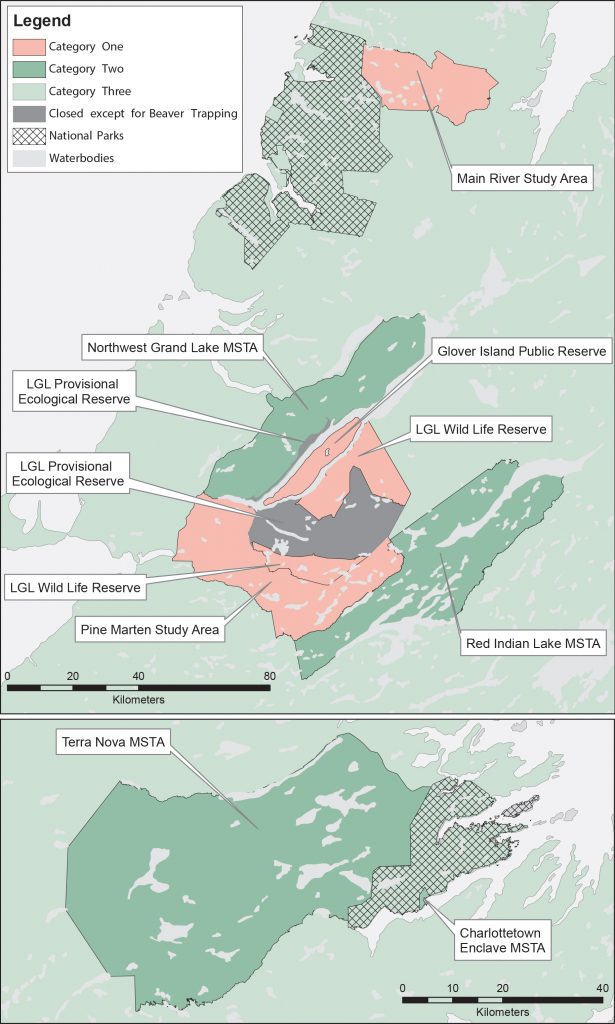The threatened Newfoundland Marten may be impacted by non-targeted mortality caused by legal trapping of furbearing species. Best management practices are designed to allow trapping techniques which minimize impact on marten, particularly in areas where marten populations are most prevalent or recovery efforts have the greatest potential.
Category One Areas
In Category One areas, traps must be set in such a manner as to avoid the capture of non-target species, specifically the Newfoundland Marten. This applies to the Pine Marten Study Area, Main River Study Area, Little Grand Lake Wildlife Reserve (LGL) and the Glover Island Public Reserve. The LGL Provisional Ecological Reserve is closed to all trapping except for beaver.
Prohibited Traps in this category would include:
- All land-based traps (including leg hold and conibear sets or dry land).
- All land-based locking neck snares (fox/lynx/coyote).
Note: Category One areas are closed to all small game snaring (including LGL Provisional Ecological Reserve).
Table 1: Permitted Traps in Category One Areas
| Trap Type and Target Species | Regulated Setting Requirements |
| Beaver Conibear | Trap jaws shall remain completely submerged requiring target species to dive. |
| Beaver Submarine Cage | Cage shall be completely submerged. |
| Beaver Snare Pole | Snares shall be completely submerged. |
| Ermine (weasel) or Squirrel Rat Trap | Victor Rat Trap, whether baited or not, shall be completely enclosed inside a wooden box with a 1.5” hole at one end. |
| Fox or Coyote or Lynx Restraining Neck Snare | Wire shall be 3/32” or greater.
A 360 degree swivel is required at the attachment point. The stop on the loop shall be fastened so that the loop will close to a minimum 8” circumference. The snare shall be fastened to an immovable object, no drags. The snare may be set with or without the use of bait. This is a live capture device and requires a 24 hour trap check. |
| Mink Conibear | Floating Mink Box – Trap shall be set in the entrance of a floating wooden box, whether or not the trap is baited, and the entrance to the box shall be completely submerged. |
| Otter or Mink or Muskrat Conibear | Trap jaws shall be completely submerged requiring target species to dive. |
| Otter or Mink or Muskrat Submarine Cage | The cage shall be completely submerged. |
| Beaver or Otter or Muskrat or Mink Slide-lock Drowner | The trap shall be a foothold type with a slide lock attached.
The trap shall be placed at least five feet from the shoreline or on a semi-submerged log with no land-based access. The water shall be sufficiently deep so as to ensure drowning. The trap may be set with or without the use of bait. |
| Squirrel Pole | Snares shall use 16 pound test snare wire attached to a horizontal or leaning pole, snares 3/4”-1’’ above the pole and having a 1.5”- 1.75” diameter loop. No bait shall be used. |
Category Two Areas
Snares/traps found in this category acknowledge the potential for accidental harvest but mitigate for marten mortality. This applies to the Red Indian Lake, Northwest Grand Lake, Terra Nova and Charlottetown Enclave modified snaring and trapping areas (MSTA). Additional Category Two areas may be considered by the Department of Fisheries & Land Resources in the future to help facilitate marten recovery.
Prohibited Traps in this category would include: All land-based traps.
Table 2: Permitted Traps in Category Two Areas
| Trap Type and Target Species | Regulated Setting Requirements |
| All those listed in Table 1 | All corresponding regulated setting requirements in Table 1 |
| Fox, Coyote or Lynx Killing Neck Snare | The snare shall be equipped with lock. The snare can be baited or not. |
Category Three Areas
Category Three allows the use of all legal snaring/trapping devices, including those listed under Categories One and Two, but also all other legal traps. Category Three areas would reflect all other landbases not covered under Category One or Two.
